Regional Atmospheric CO2 Response to Ecosystem CO2 Budgets in China
Abstract
1. Introduction
2. Materials and Methods
2.1. Data Collection
2.2. NEE Estimation Model Construction
2.3. Sensitivity Analysis of Regional Atmospheric CO2 to Regional CO2 Budget
3. Results and Discussion
3.1. Regional Terrestrial NEE, CO2 Emissions, and Atmospheric CO2 Content
3.2. Regional Terrestrial NEE, CO2 Emissions, and Atmospheric CO2 Content
3.3. Emission Allocation Policies Related to CO2 Budgets
4. Conclusions
Author Contributions
Funding
Data Availability Statement
Acknowledgments
Conflicts of Interest
Appendix A
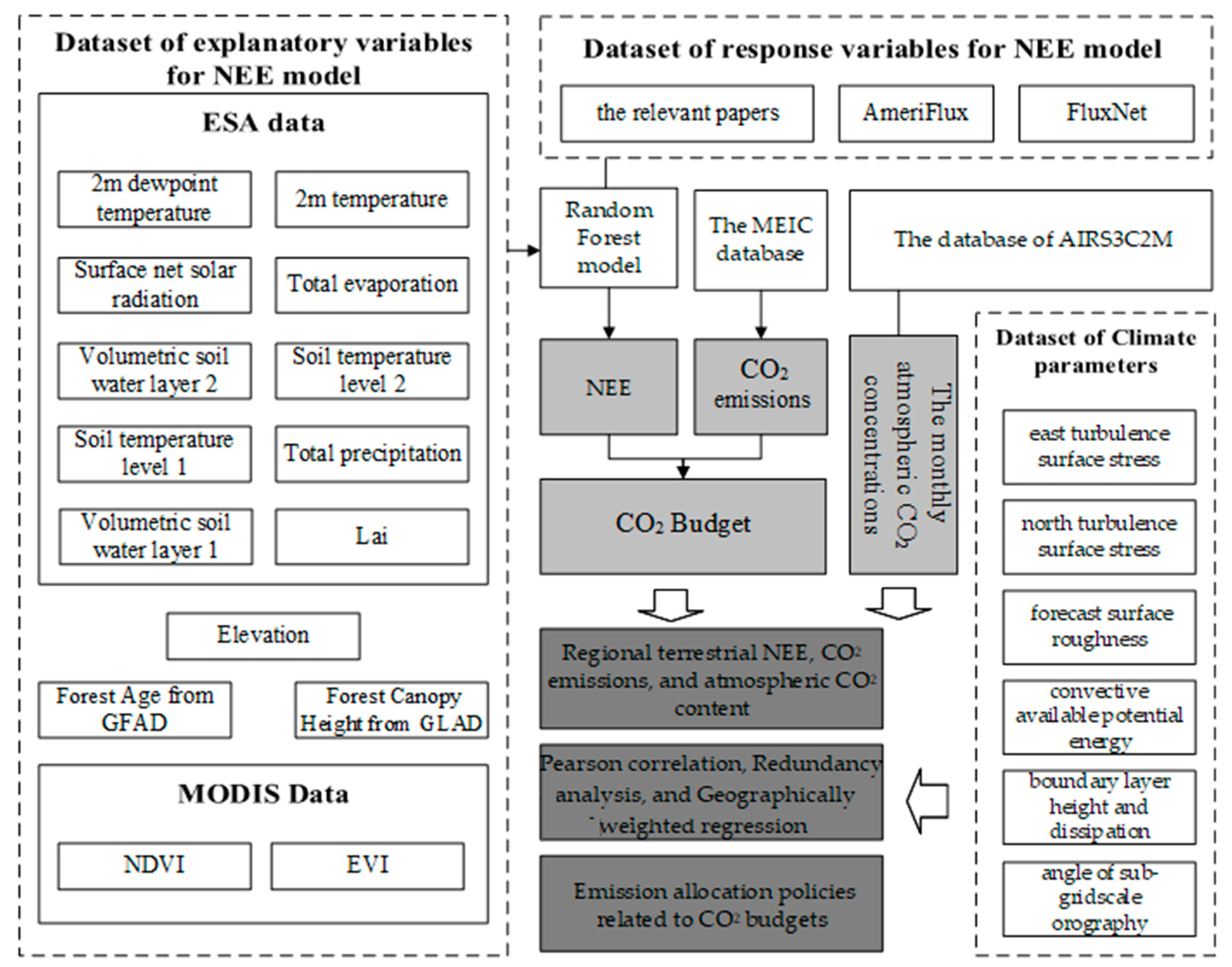
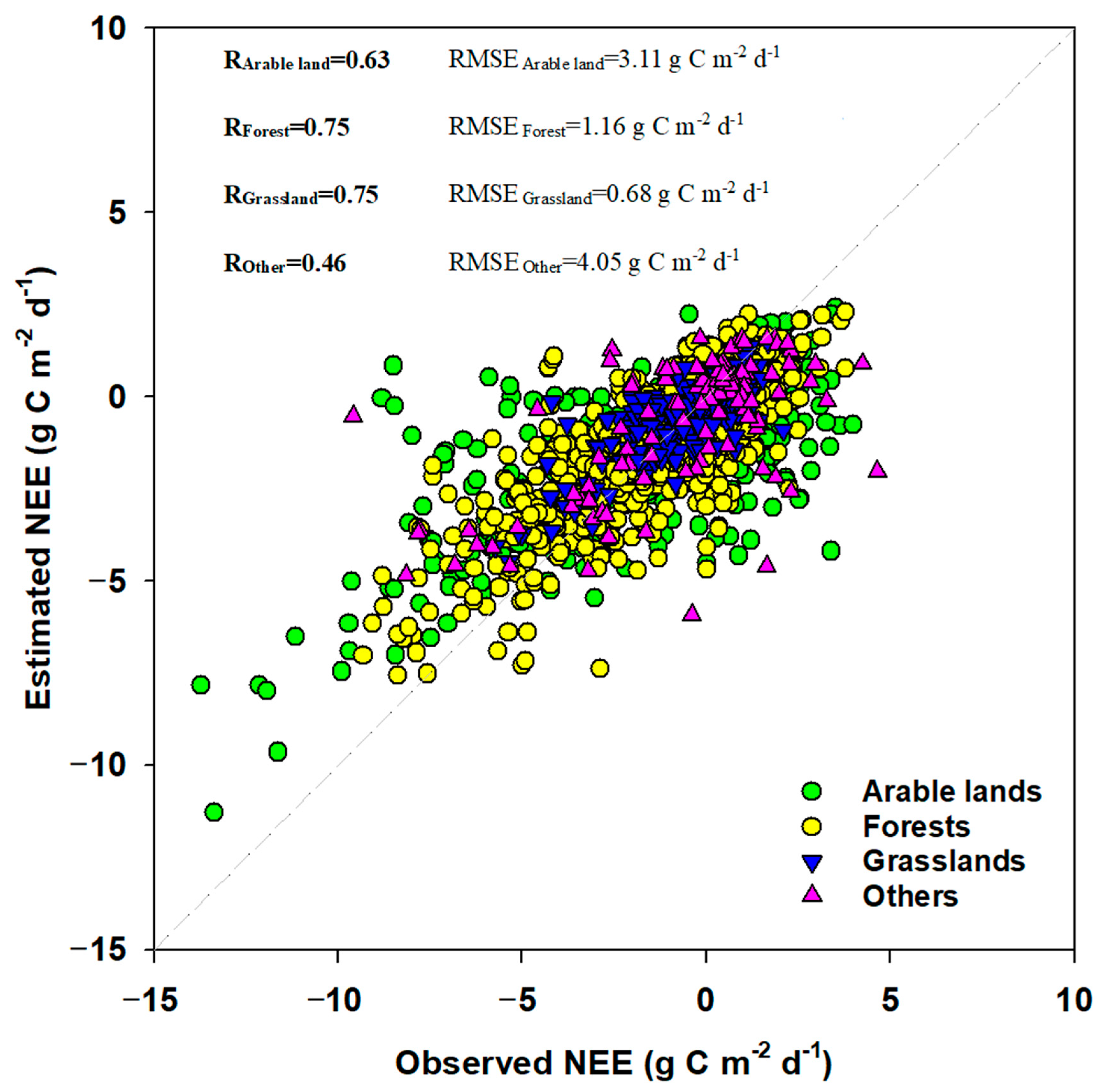
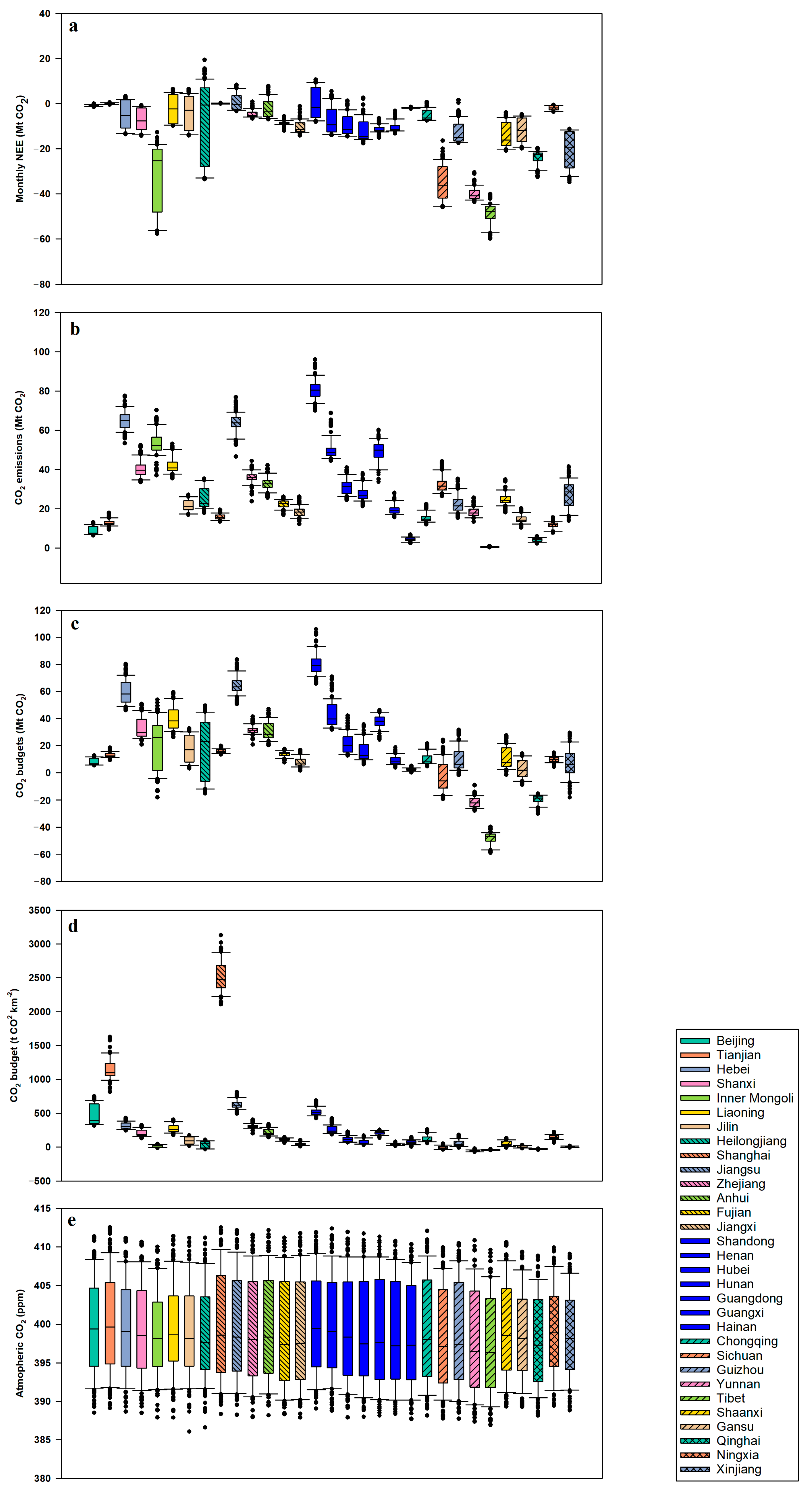

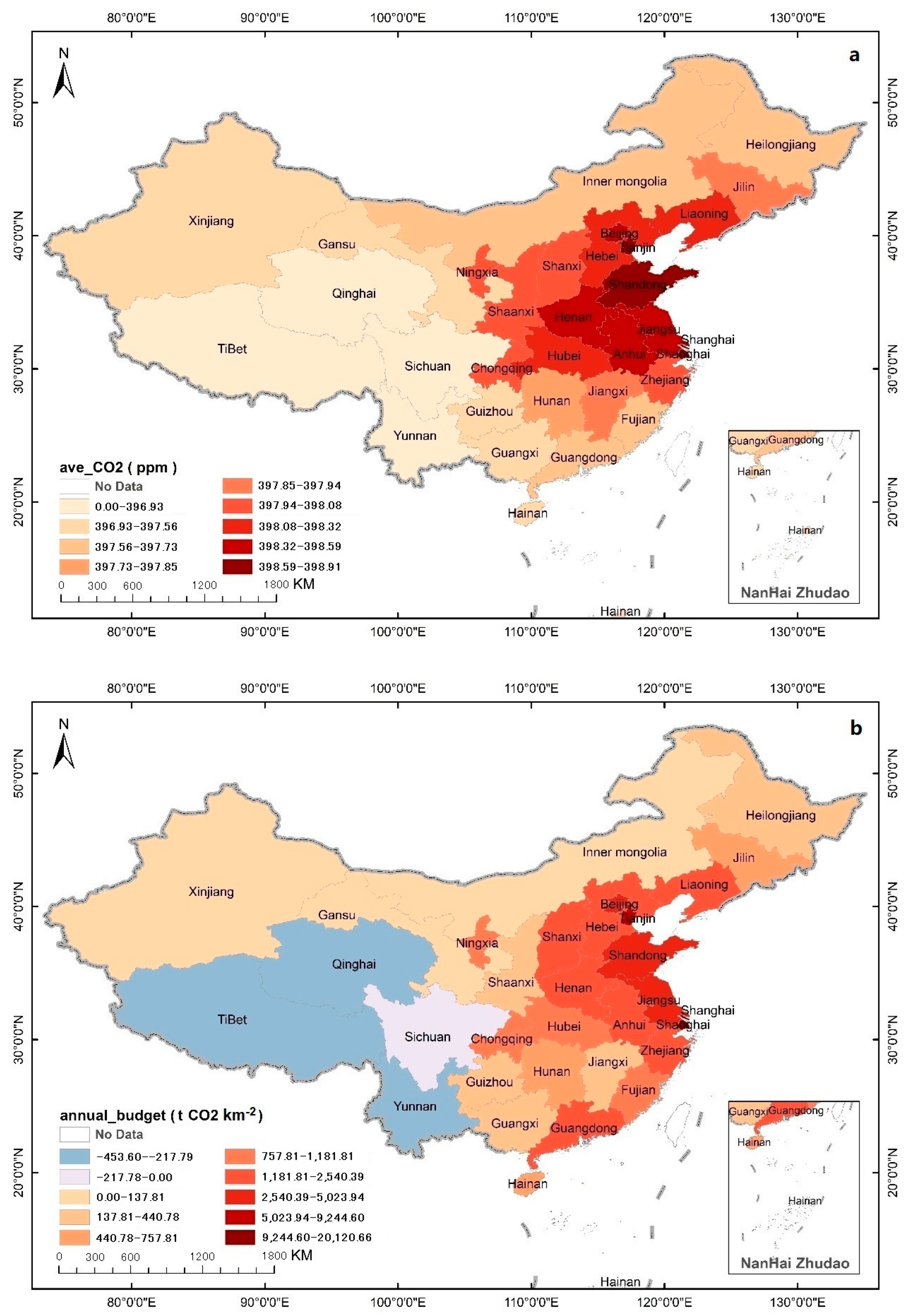

References
- Dong, L.; Miao, G.; Wen, W. China’s Carbon Neutrality Policy: Objectives, Impacts and Paths. East Asian Policy 2021, 13, 5–18. [Google Scholar] [CrossRef]
- Jiang, H.; Shao, X.; Zhang, X.; Bao, J. A Study of the Allocation of Carbon Emission Permits among the Provinces of China Based on Fairness and Efficiency. Sustainability 2017, 9, 2122. [Google Scholar] [CrossRef]
- Fang, G.; Liu, M.; Tian, L.; Fu, M.; Zhang, Y. Optimization Analysis of Carbon Emission Rights Allocation Based on Energy Justice—The Case of China. J. Clean. Prod. 2018, 202, 748–758. [Google Scholar] [CrossRef]
- Zhou, H.; Ping, W.; Wang, Y.; Wang, Y.; Liu, K. China’s Initial Allocation of Interprovincial Carbon Emission Rights Considering Historical Carbon Transfers: Program Design and Efficiency Evaluation. Ecol. Indic. 2021, 121, 106918. [Google Scholar] [CrossRef]
- Sim, J. A Carbon Emission Evaluation Model for a Container Terminal. J. Clean. Prod. 2018, 186, 526–533. [Google Scholar] [CrossRef]
- Baldocchi, D.; Penuelas, J. The Physics and Ecology of Mining Carbon Dioxide from the Atmosphere by Ecosystems. Glob. Chang. Biol. 2019, 25, 1191–1197. [Google Scholar] [CrossRef]
- Sengupta, S.; Gorain, P.C.; Pal, R. Aspects and Prospects of Algal Carbon Capture and Sequestration in Ecosystems: A Review. Chem. Ecol. 2017, 33, 695–707. [Google Scholar] [CrossRef]
- Rivela, C.B.; Blanco, M.B.; Teruel, M.A. Atmospheric Degradation of Industrial Fluorinated Acrylates and Methacrylates with Cl Atoms at Atmospheric Pressure and 298 K. Atmos. Environ. 2018, 178, 206–213. [Google Scholar] [CrossRef]
- Yang, Y.; Liu, L.; Zhang, F.; Zhang, X.; Xu, W.; Liu, X.; Wang, Z.; Xie, Y. Soil Nitrous Oxide Emissions by Atmospheric Nitrogen Deposition over Global Agricultural Systems. Environ. Sci. Technol. 2021, 55, 4420–4429. [Google Scholar] [CrossRef]
- Wuebbles, D.J.; Hayhoe, K. Atmospheric Methane and Global Change. Earth Sci. Rev. 2002, 57, 177–210. [Google Scholar] [CrossRef]
- Nakazawa, T. Current Understanding of the Global Cycling of Carbon Dioxide, Methane, and Nitrous Oxide. Proc. Jpn. Acad. Ser. B 2020, 96, 394–419. [Google Scholar] [CrossRef] [PubMed]
- Siljanen, H.M.P.; Welti, N.; Voigt, C.; Heiskanen, J.; Biasi, C.; Martikainen, P.J. Atmospheric Impact of Nitrous Oxide Uptake by Boreal Forest Soils Can Be Comparable to That of Methane Uptake. Plant Soil 2020, 454, 121–138. [Google Scholar] [CrossRef]
- Fu, C.; Dan, L.; Feng, J.; Peng, J.; Yin, N. Temporal and Spatial Heterogeneous Distribution of Tropospheric CO2 over China and Its Possible Genesis. Chin. J. Geophys. 2018, 61, 4373–4382. [Google Scholar] [CrossRef]
- Zhang, C.; Wu, G.; Wang, H.; Wang, Y.; Gong, D.; Wang, B. Regional Effect as a Probe of Atmospheric Carbon Dioxide Reduction in Southern China. J. Clean. Prod. 2022, 340, 130713. [Google Scholar] [CrossRef]
- Lian, Y.; Li, H.; Renyang, Q.; Liu, L.; Dong, J.; Liu, X.; Qu, Z.; Lee, L.-C.; Chen, L.; Wang, D.; et al. Mapping the Net Ecosystem Exchange of CO2 of Global Terrestrial Systems. Int. J. Appl. Earth Obs. Geoinf. 2023, 116, 103176. [Google Scholar] [CrossRef]
- Oksanen, J.; Kindt, R.; Legendre, P.; O’Hara, B.; Stevens, M.H.H.; Oksanen, M.J.; Suggests, M. The Vegan Package. Community Ecol. Package 2007, 10, 719. [Google Scholar]
- Fotheringham, A.S.; Brunsdon, C.; Charlton, M. Geographically Weighted Regression: The Analysis of Spatially Varying Relationships; John Wiley & Sons: Hoboken, NJ, USA, 2003. [Google Scholar]
- Huang, N.; Wang, L.; Zhang, Y.; Gao, S.; Niu, Z. Estimating the Net Ecosystem Exchange at Global FLUXNET Sites Using a Random Forest Model. IEEE J. Sel. Top. Appl. Earth Obs. Remote Sens. 2021, 14, 9826–9836. [Google Scholar] [CrossRef]
- Zhou, Y.; Zhang, J.; Yin, C.; Huang, H.; Sun, S.; Meng, P. Empirical Analysis of the Influences of Meteorological Factors on the Interannual Variations in Carbon Fluxes of a Quercus Variabilis Plantation. Agric. For. Meteorol. 2022, 326, 109190. [Google Scholar] [CrossRef]
- Yang, J.; Duan, Y.; Yang, X.; Awasthi, M.K.; Li, H.; Zhang, L. Modeling CO2 Exchange and Meteorological Factors of an Apple Orchard Using Partial Least Square Regression. Environ. Sci. Pollut. Res. 2020, 27, 43439–43451. [Google Scholar] [CrossRef]
- Hernández-Paniagua, I.Y.; Lowry, D.; Clemitshaw, K.C.; Fisher, R.E.; France, J.L.; Lanoisellé, M.; Ramonet, M.; Nisbet, E.G. Diurnal, Seasonal, and Annual Trends in Atmospheric CO2 at Southwest London during 2000–2012: Wind Sector Analysis and Comparison with Mace Head, Ireland. Atmos. Environ. 2015, 105, 138–147. [Google Scholar] [CrossRef]
- Lauderdale, J.M.; Garabato, A.C.N.; Oliver, K.I.C.; Follows, M.J.; Williams, R.G. Wind-Driven Changes in Southern Ocean Residual Circulation, Ocean Carbon Reservoirs and Atmospheric CO2. Clim. Dyn. 2013, 41, 2145–2164. [Google Scholar] [CrossRef]
- Jia, W.; Zhang, X. The Role of the Planetary Boundary Layer Parameterization Schemes on the Meteorological and Aerosol Pollution Simulations: A Review. Atmos. Res. 2020, 239, 104890. [Google Scholar] [CrossRef]
- Lee, J.; Hong, J.-W.; Lee, K.; Hong, J.; Velasco, E.; Lim, Y.J.; Lee, J.B.; Nam, K.; Park, J. Ceilometer Monitoring of Boundary-Layer Height and Its Application in Evaluating the Dilution Effect on Air Pollution. Bound. Layer Meteorol. 2019, 172, 435–455. [Google Scholar] [CrossRef]
- Wang, J.; Yang, Y.; Zhang, X.; Liu, H.; Che, H.; Shen, X.; Wang, Y. On the Influence of Atmospheric Super-Saturation Layer on China’s Heavy Haze-Fog Events. Atmos. Environ. 2017, 171, 261–271. [Google Scholar] [CrossRef]
- Lee, J.Y.; Kim, H.; Gasparrini, A.; Armstrong, B.; Bell, M.L.; Sera, F.; Lavigne, E.; Abrutzky, R.; Tong, S.; Coelho, M.d.S.Z.S.; et al. Predicted Temperature-Increase-Induced Global Health Burden and Its Regional Variability. Environ. Int. 2019, 131, 105027. [Google Scholar] [CrossRef]
- Lammertsma, E.I.; de Boer, H.J.; Dekker, S.C.; Dilcher, D.L.; Lotter, A.F.; Wagner-Cremer, F. Global CO2 Rise Leads to Reduced Maximum Stomatal Conductance in Florida Vegetation. Proc. Natl. Acad. Sci. USA 2011, 108, 4035–4040. [Google Scholar] [CrossRef]
- Fernández-Martínez, M.; Sardans, J.; Chevallier, F.; Ciais, P.; Obersteiner, M.; Vicca, S.; Canadell, J.G.; Bastos, A.; Friedlingstein, P.; Sitch, S.; et al. Global Trends in Carbon Sinks and Their Relationships with CO2 and Temperature. Nat. Clim. Chang. 2019, 9, 73–79. [Google Scholar] [CrossRef]
- Zhang, Y.; Liu, X.; Lei, L.; Liu, L. Estimating Global Anthropogenic CO2 Gridded Emissions Using a Data-Driven Stacked Random Forest Regression Model. Remote Sens. 2022, 14, 3899. [Google Scholar] [CrossRef]
- Wang, J.; Cai, B.; Zhang, L.; Cao, D.; Liu, L.; Zhou, Y.; Zhang, Z.; Xue, W. High Resolution Carbon Dioxide Emission Gridded Data for China Derived from Point Sources. Environ. Sci. Technol. 2014, 48, 7085–7093. [Google Scholar] [CrossRef]
- Chen, B.; Zhang, H.; Wang, T.; Zhang, X. An Atmospheric Perspective on the Carbon Budgets of Terrestrial Ecosystems in China: Progress and Challenges. Sci. Bull. 2021, 66, 1713–1718. [Google Scholar] [CrossRef]
- Wang, J.; Feng, L.; Palmer, P.I.; Liu, Y.; Fang, S.; Bösch, H.; O’Dell, C.W.; Tang, X.; Yang, D.; Liu, L.; et al. Large Chinese Land Carbon Sink Estimated from Atmospheric Carbon Dioxide Data. Nature 2020, 586, 720–723. [Google Scholar] [CrossRef] [PubMed]
- Wang, F.; Cao, M.; Wang, B.; Fu, J.; Luo, W.; Ma, J. Seasonal Variation of CO2 Diffusion Flux from a Large Subtropical Reservoir in East China. Atmos. Environ. 2015, 103, 129–137. [Google Scholar] [CrossRef]
- Semlali, B.-E.B.; Amrani, C.E. A Stream Processing Software for Air Quality Satellite Datasets. In Advanced Intelligent Systems for Sustainable Development (AI2SD’2020); Kacprzyk, J., Balas, V.E., Ezziyyani, M., Eds.; Springer International Publishing: Cham, Switzerland, 2022; pp. 839–853. [Google Scholar]
- Semlali, B.-E.B.; Amrani, C.E.; Ortiz, G.; Boubeta-Puig, J.; Garcia-de-Prado, A. SAT-CEP-Monitor: An Air Quality Monitoring Software Architecture Combining Complex Event Processing with Satellite Remote Sensing. Comput. Electr. Eng. 2021, 93, 107257. [Google Scholar] [CrossRef]
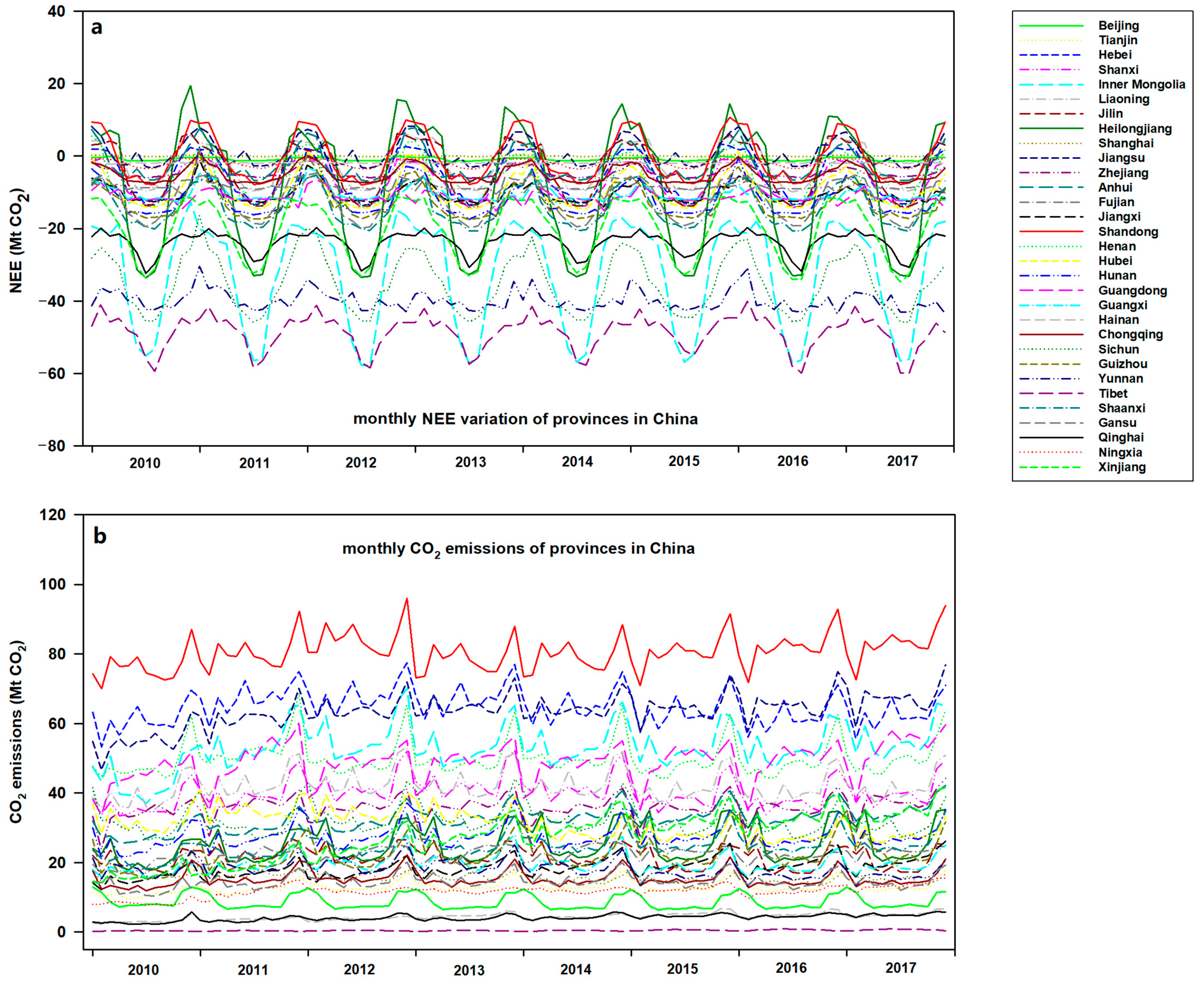

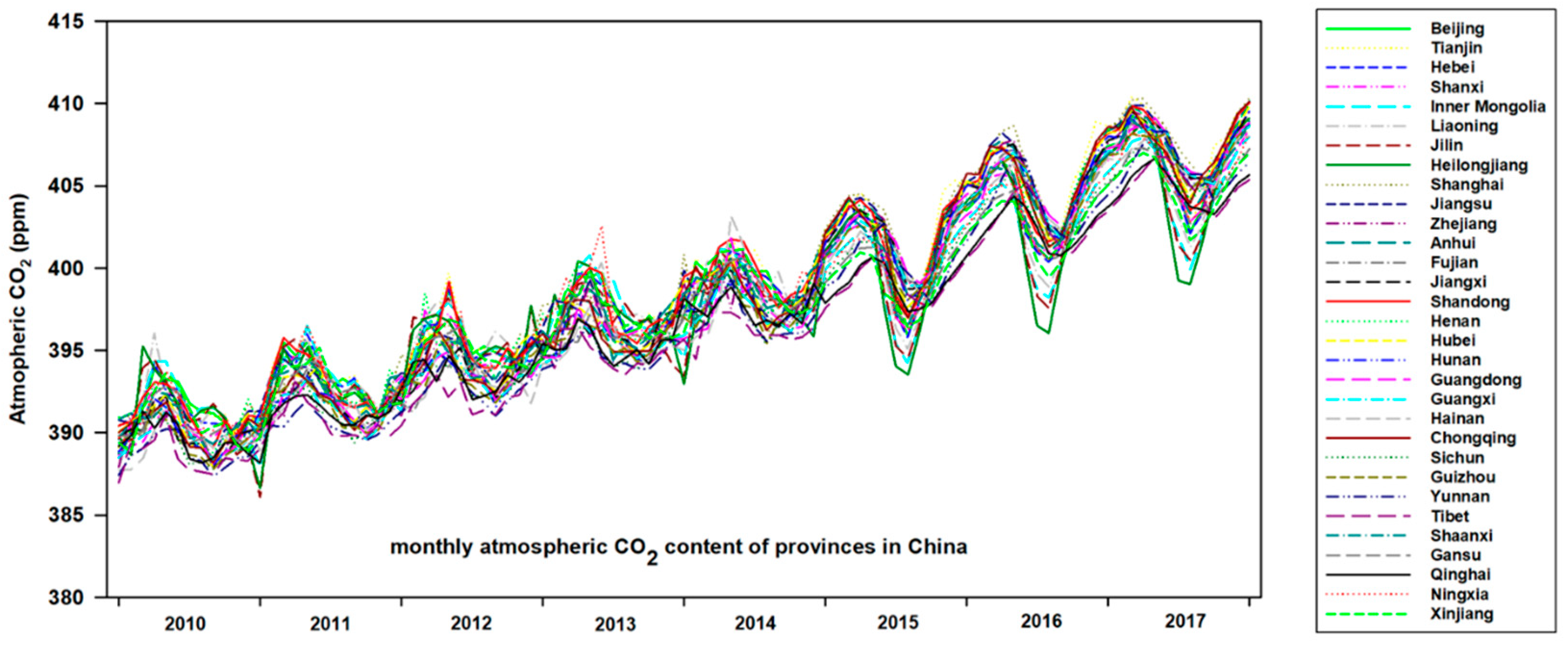



Disclaimer/Publisher’s Note: The statements, opinions and data contained in all publications are solely those of the individual author(s) and contributor(s) and not of MDPI and/or the editor(s). MDPI and/or the editor(s) disclaim responsibility for any injury to people or property resulting from any ideas, methods, instructions or products referred to in the content. |
© 2023 by the authors. Licensee MDPI, Basel, Switzerland. This article is an open access article distributed under the terms and conditions of the Creative Commons Attribution (CC BY) license (https://creativecommons.org/licenses/by/4.0/).
Share and Cite
Li, H.; Lian, Y.; Renyang, Q.; Liu, L.; Qu, Z.; Lee, L.-C. Regional Atmospheric CO2 Response to Ecosystem CO2 Budgets in China. Remote Sens. 2023, 15, 3320. https://doi.org/10.3390/rs15133320
Li H, Lian Y, Renyang Q, Liu L, Qu Z, Lee L-C. Regional Atmospheric CO2 Response to Ecosystem CO2 Budgets in China. Remote Sensing. 2023; 15(13):3320. https://doi.org/10.3390/rs15133320
Chicago/Turabian StyleLi, Haixiao, Yi Lian, Qianqian Renyang, Le Liu, Zihan Qu, and Lien-Chieh Lee. 2023. "Regional Atmospheric CO2 Response to Ecosystem CO2 Budgets in China" Remote Sensing 15, no. 13: 3320. https://doi.org/10.3390/rs15133320
APA StyleLi, H., Lian, Y., Renyang, Q., Liu, L., Qu, Z., & Lee, L.-C. (2023). Regional Atmospheric CO2 Response to Ecosystem CO2 Budgets in China. Remote Sensing, 15(13), 3320. https://doi.org/10.3390/rs15133320




